About five years ago, my roommates and I invested in an old-timey punch clock to solve a few co-habitation issues. It came with these little discontinued cards and made a spooky clicking noise, but it helped us stay informed regarding who left that pan to soak in the sink for two days. Each roommate would clock in to do their chores and keep track of the hard work they put in at the sink.
The clock was fun in a retro, connect-with-your-factory-working-ancestors kind of way, but there were challenges that we couldn't overcome even with Tock the Clock's help.
I could see that Danny spent 30 minutes at the sink, but I had no idea what he was doing since the pan was still there soaking afterward. I couldn't really blame Tock—after all, it worked well for my grandfather's generation. We needed a solution that tracked time but also informed the collective residents, even briefly, of what was being done, which tasks were taken care of, and which ones still needed to be done. Since we were bored and wanted to find the ultimate dishwashing time management tool, we transitioned to timesheets.
You may think punch clocks and timesheets are overkill, but our co-habitation situation at the time required some old-school solutions to prevent anarchy and piled-up problems in the sink. Timesheet tools can make a huge difference, and that's as true for my old roommates as it is for your business.
Table of contents:
What is a timesheet?
A timesheet is a document that keeps track of the amount of time someone spends on a project over a certain period. It offers everything the old-timey clock does with an extra dash of detailed information, such as project progress, tasks, and milestones that keep teams aligned.
While punch clocks were frequently used by corporate offices filled with cubicle-shaped despair to track their employees' clock-in and clock-out times for each day, timesheets provide much more context and utility. For example, modern businesses use timesheets to accurately report time spent on specific tasks, activities, and projects. Managers, HR specialists, and company leaders can then easily monitor project progress, resource allocation, and payroll details.
The basic elements of a timesheet include the company's info, the employee's name, the timeframe that's being tracked, and the work hours completed. Even the most basic timesheet should, at the very least, inform you of the amount of work each employee accomplishes during a certain timeframe.
The timesheet can be a paper document, a digital spreadsheet, or software—which one you choose depends on what works best for your company and how you prioritize each project or task. As the former managing director of one kitchen sink in an apartment too small, I recommend spreadsheets and software, because Danny might "accidentally" destroy your timesheet paper with water just as his performance review is around the corner, or struggle to keep his timesheet record organized once he hits his 189th session at the sink.
With that being said, here are a few Danny-vetted timesheet templates that you can adopt.
1. Standard weekly timesheet template
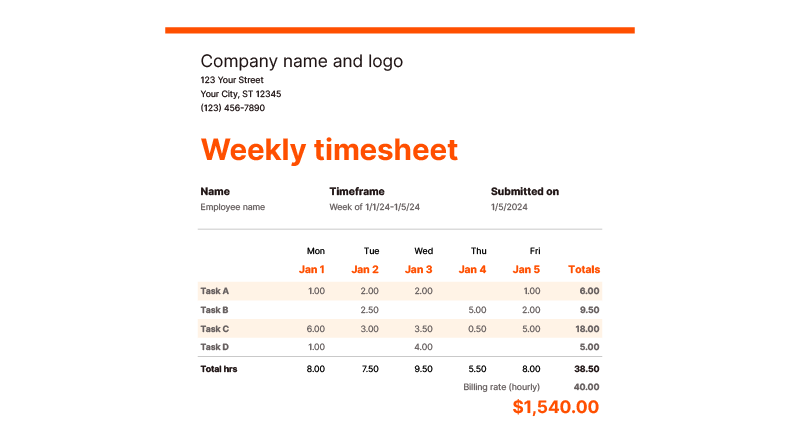
The standard weekly timesheet template contains all the basic elements. It tracks time allocation for multiple projects over a five-day workweek, something you can easily customize to fit your company's needs. Input the number of hours an employee has spent on each project, and adjust the hourly billing rate. The template is set up to automatically calculate the total number of hours worked and billing due.
The second page of the timesheet outlines project details. Employees can use it to outline their efforts for each project, note their progress, and if needed for collaborative efforts, update their team on what they've accomplished.
Tip: Encourage your team to use the notes section for collaborative discussions.
2. Biweekly timesheet template
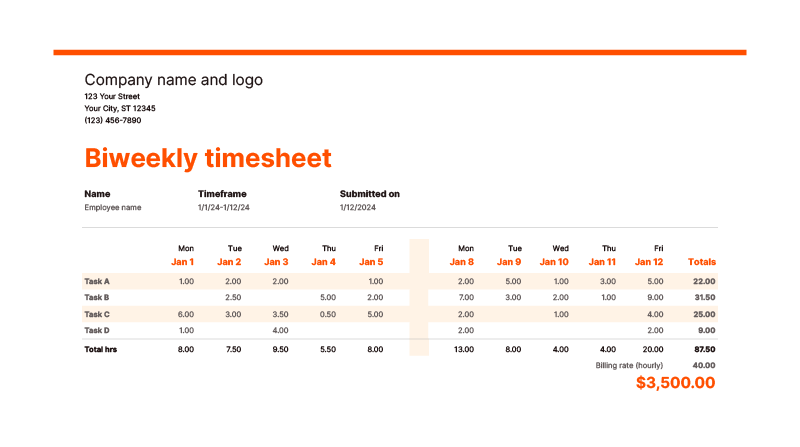
The biweekly timesheet accommodates tracking time for projects that span—you guessed it—two-week periods. It contains the same basic elements, outlining daily hours, dates, billing totals, and a page dedicated to project details.
It's best used for businesses that adopt a biweekly approach to their payroll or operations. Considering the longer period of time, it's best to keep project details separated by week and make sure that information isn't condensed into a single box. This helps minimize confusion and enables more detailed notes and reports.
Tip: Use the notes section to summarize biweekly progress for each project and keep information digestible at a glance for the rest of the team.
3. Hourly employee timesheet template

This timesheet is the simplest version and performs the same function that Tock the Clock did for our kitchen, with the added benefit of a page outlining project details. This function would have been useful to outline who did the cutlery, who was soaking the pan, and maybe host a note warning against opening the kitchen drawer too fast or it'll come loose, scattering spoons, hopes, and dreams all over the floor.
This template benefits businesses that track hourly activities to accommodate situations like advisors, temporary or part-time workers, and consultants.
Tip: Train your employees in utilizing time management strategies that work in tandem with hourly time tracking, like time blocking, timers, and batching tasks.
4. Daily timesheet template
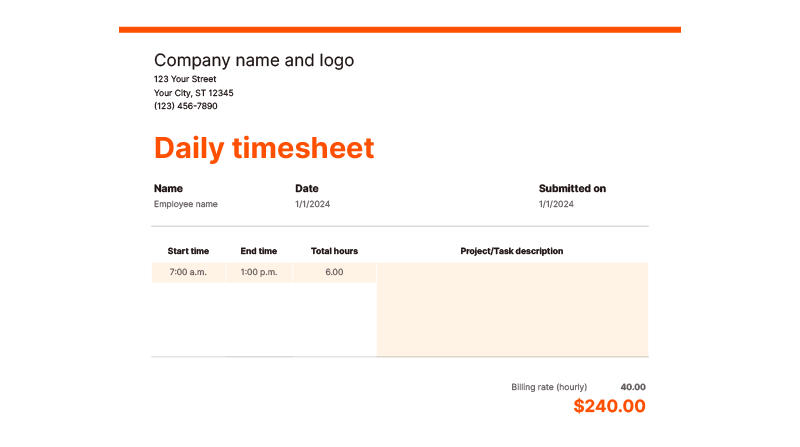
The daily timesheet template tracks activities on a day-to-day basis. This is most useful for operations that require a daily report or update, like daily sales volumes, event attendance, or training progress. Each day is tracked on its own page, outlining start and end times, total hours worked, and project or task descriptions.
The dedicated description section for each day can be especially useful for teams that don't always work in close proximity or don't collaborate on the same project for extended periods of time.
Tip: Create a new tab for each day and title it with the date to keep your daily timesheets organized as they start piling up.
5. Freelancer timesheet template
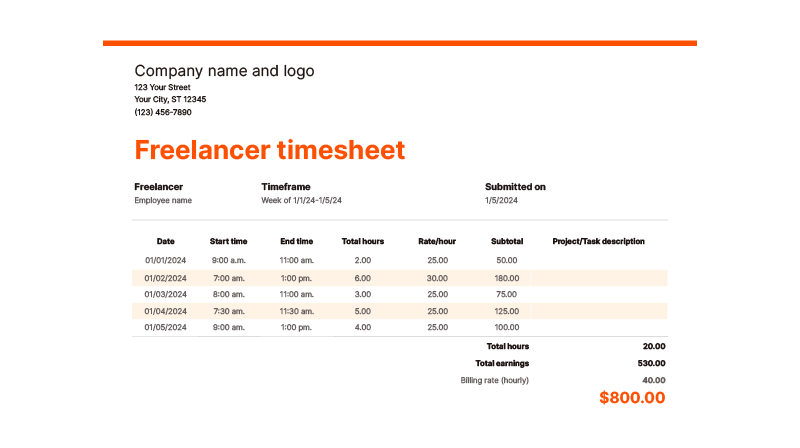
This timesheet is designed to track the flexible details of freelancer work. Alongside tracking hours, start times, and end times, it also tracks the freelancer's hourly rates, their total daily earnings, and the amount they are due throughout the project.
Tip: Customize the timesheet to fit your freelancer's entire contracted period to aggregate their work, progress, and billable hours in one document.
6. Client billing timesheet template
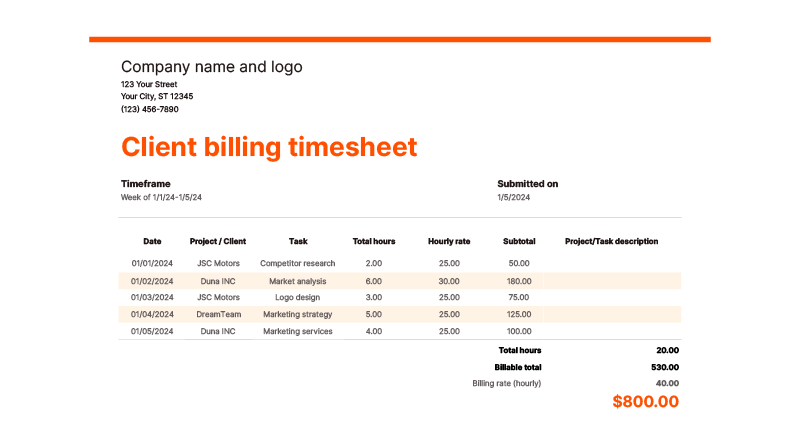
This timesheet template is useful for companies that track their daily billable hours for each client over time. It's designed to outline the particular task or project being worked on, the stage it's at, and the rates for each service.
For example, a marketing agency's advertising services may be more expensive than its market analysis services. This timesheet template keeps track of all this information for better visibility of its revenue over time.
Tip: Color-code your clients on the timesheet to better analyze their significance in terms of revenue and time consumption.
7. Consultant timesheet template
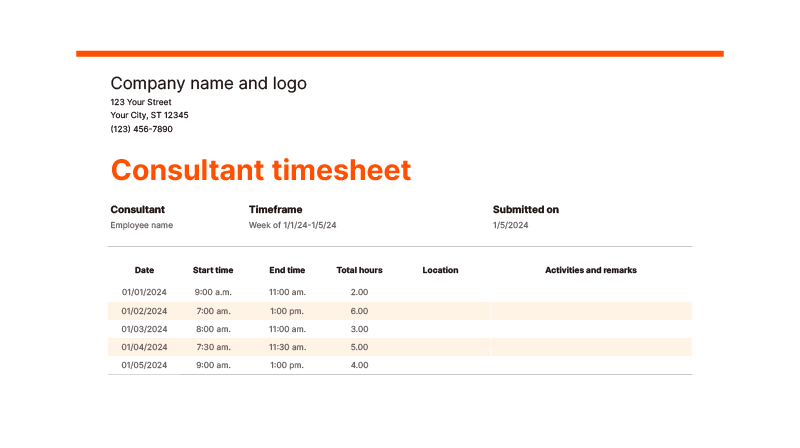
This timesheet template is designed to track a consultant's daily work. Considering many consultants charge a flat fee for their services, this timesheet isn't designed to track total earnings.
It also outlines the various locations the consultant may visit or work in. Companies that hire consultants sometimes need them to move through different facilities to get their expert opinions on what can be improved.
Tip: Aggregate your consultant's activity remarks into a separate document you can use later to review their observations and incorporate their feedback to streamline your business operations.
8. Timesheet for multiple projects
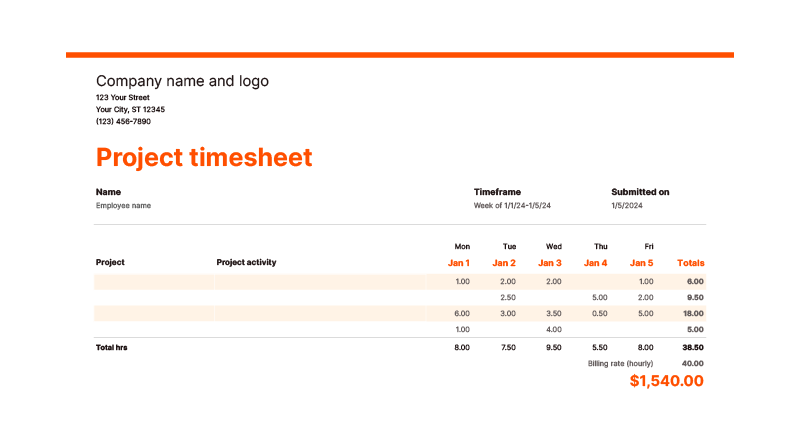
This timesheet template is designed to keep track of multiple projects over time. It includes fillable sections that identify the project, activities undertaken within it, and the tracked time for each day.
My roommates and I could have used this template to track our different endeavors, from cutlery cleaning and pan soaking to nailing that pesky drawer shut once and for all. Our kitchen was a high-tension environment, and there were always multiple ongoing projects. Don't let this be your reality.
Tip: Once the timesheet is beginning to fill up, use the project details tab to group project activities together, creating a detailed summary of work done for each project.
9. Task-based timesheet template
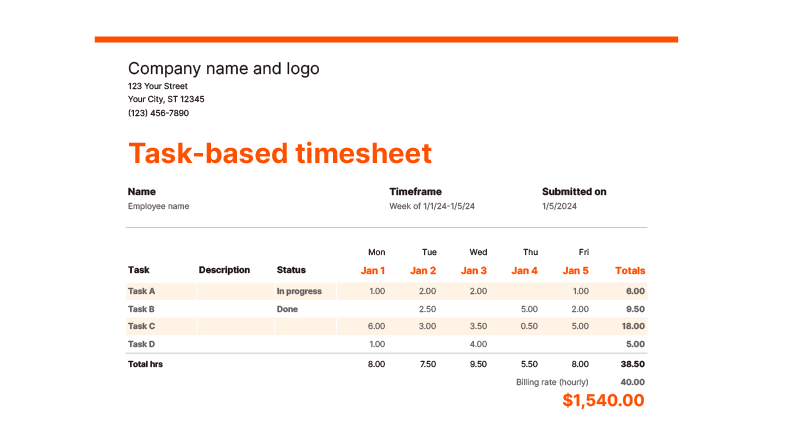
The task-based timesheet allows users to track specific tasks, input descriptions, and designate their status, whether they're in progress, completed, or halted. This makes it easier for readers to quickly scan the document and know exactly where each task sits.
Tip: Use the task description section to outline the details of the task, and use the project details notes to go in-depth regarding any issues, updates, or reasons for delays.
10. Payroll timesheet template
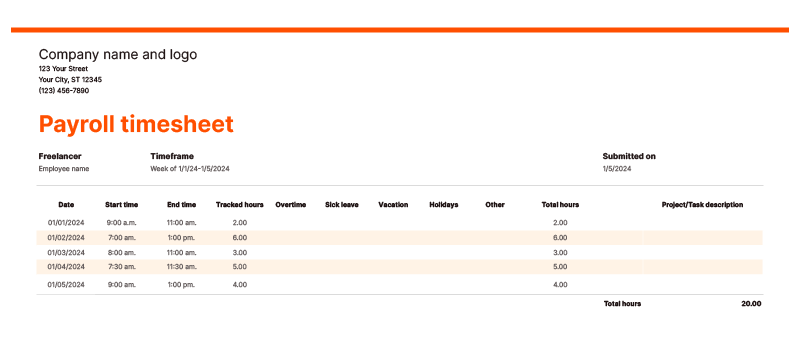
The payroll timesheet template outlines hours worked alongside any overtime, vacation, sick leave, and holidays that need to be considered. It simplifies matters for your HR department and helps them keep each employee's billable hours organized and well-documented.
Tip: Incorporate any holidays your company observes into the timesheet, so those days are always tracked and added automatically and employees only need to input their own work hours.
11. Field service timesheet template

The field service timesheet is designed for work performed on various sites, be it construction sites, homes, or public property. Companies that engage in physical labor or whose services require a specialist can use this timesheet template to better track employee hours, work, location of work, and any notes they may have.
Tip: Leverage the timesheet to get detailed reports from your employees. Leadership may not always have visibility regarding on-site projects, making the notes section on this timesheet an especially valuable tool.
12. Contractor timesheet template
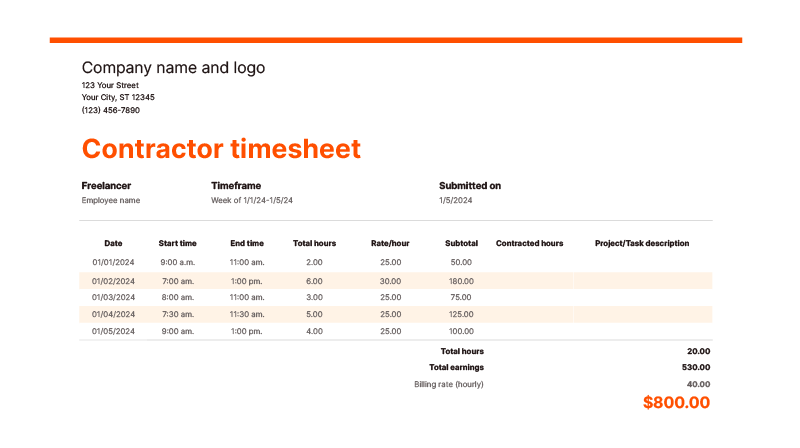
This timesheet template helps track a contractor's work hours, billing rates, and contracted hours. Generally, companies that engage contractors will have already established an agreed-upon number of work hours. By outlining the contracted hours in the timesheet, both the business and the contractor can easily discern milestones to hit.
Tip: Adjust the timesheet to reflect your company's preferred billing cycle (weekly, biweekly, or monthly), so it remains compatible with any other payroll documents or tools your team is already using.
How to use a timesheet template
Incorporating a timesheet into your team's process boils down to clear instructions and training. With that in place, it takes a bit of time and practice to streamline the process.
It took Danny four days to realize that he was punching his time in on Tock the Clock but never punching out. We were halfway through making the intervention banner to address his soapy sink problem before we realized what was happening.
Your team will likely go through a similar adjustment period. Make sure you have documentation outlining how to use the timesheet, how to track and log their hours, and the company policies regarding matters like breaks and overtime.
Depending on the time period you're tracking, the timesheet can be filled out in a number of ways. Some employees prefer to track their time live or mark their hours at the end of the day. Others will be more comfortable logging their hours on a weekly basis. Determine what works best for your business and adjust accordingly.
Timesheets on their own have limitations. However, there are ways to complement these documents by integrating time tracking software tools that can automate data entry and time logging.
Timesheet FAQ
We spent the first few days after Tock the Clock moved into our home trying to figure out, through trial and error, how we could best use it to solve our kitchen issues. We managed to find the answers in the end, but we would have probably saved a lot of time, effort, water, and soap if we had done our research beforehand. To save you the experience, I've put together some frequently asked questions about timesheets.
How do I choose the right timesheet template for my business?
Start by identifying the timeframe that works best for your company. Once you know whether you'd like to track time on a daily, weekly, biweekly, or monthly basis, you can filter the timesheet templates based on the nature of your work.
Businesses with a focus on large-scale projects would benefit from the task-based timesheet template, whereas companies that employ a lot of freelancers would likely find the freelancer and contractor timesheet templates more useful.
Are there any legal implications associated with timesheets?
Before you implement timesheets into your process, make sure you do your research regarding compliance with labor laws and regulations in your region. You'll also want to emphasize the importance of accurate recordkeeping to employees.
Create a document that addresses any local legal requirements, and distribute it throughout your company before implementing timesheets.
How can I ensure employee compliance and accuracy in filling out timesheets?
The best way to maintain accuracy is to utilize software to track the exact number of hours worked and consistently assess time tracking activities.
Extensive training and supervision can help guide your workforce to be compliant with regulations.
Automate time tracking with Zapier
Timesheets can make a difference in your time tracking efforts and change how your team operates. They add structure and visibility—the kind that turned Danny from a pan-soaking expert to the most efficient dishwasher I've ever seen.
But timesheets have their limitations, and they require a decent amount of manual data entry. This is where software comes in. The best time tracking software will automatically track your time, log it, and calculate everything from total hours worked and billing details to subtracted leave and holidays.
Time tracking software offers a lot of features designed to simplify and automate the time-consuming manual input and data entry of a timesheet. And Zapier can help connect your time tracking tools to your other HR software to streamline your operations. Learn more about how to automate time tracking with dedicated software.
If you decide to stick with these Google Sheets timesheet templates, you can automate your spreadsheets, so they still work with all the apps you already use at work.
Related reading:






